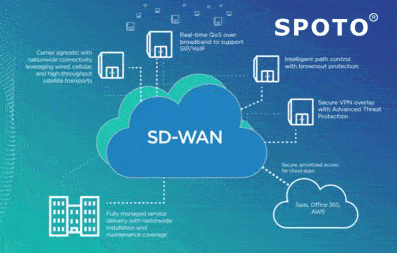Cisco SD-WAN Components You Should Know

SD-WANs are considered to be a new form of corporate connectivity, which would be designed for adapting to modern IT practices as well as the connections to the cloud. In the past, corporations that would be building their own WANs utilizing proprietary hardware as well as service-provider network connections amongst the data centers, but that would be all changing. Applications are considered to be moving to the cloud and Internet broadband costs would be declining, paving the way to creating virtual WANs that would be tied together for leveraging Internet broadband utilizing software and COTS hardware (commodity off-the-shelf).
Before we check out some of the components of Cisco SD-WAN, if you would be looking for more knowledge, you could check out the training courses which would be offered by the SPOTO Club.
SD-WAN for Router Replacement
Technology professionals would like to talk about “use cases” for emerging technology. These would be useful reference points for why the technology would be purchased or implemented, though they aren’t the be-all or end-all. The SD-WAN market would be containing many use cases as well as features that would be appealing to the different enterprises as well as service providers. Many of the SD-WAN vendors and managed service providers would be focusing on specific niches. For that reason, we would have to try to highlight some of the specific requirements as well as features being sought by specific customers.
One of the more popular functions of SD-WAN is considered to be the router replacement or router consolidation. One of the higher costs of WAN frequently cited by enterprise customers is considered to be the operating expense (OPEX) of managing proprietary hardware as well as CPE (customer premises equipment), which would be including branch-office routers. Additionally, hiring certified specialists for managing these branch-office routers is quite expensive.
SD-WAN Security Functions
Another allure of SD-WAN technology is that it could be utilized for deploying security functions like the VPN (virtual private network) as a software overlay utilizing end-to-end encryption. This would be able to help you to meet security requirements for businesses that might wish to connect branch offices or retail outlets but would be also having high-security requirements.
SD-WANs, because they would be virtual networks controlled from the cloud, also have the suppleness to plug in additional security functions without specialized hardware. Value-added security services like the stronger encryption as well as IDS (intrusion detection services) could be offered by the SD-WAN providers. This could be a matter for debating, as some SD-WAN providers would believe some security services, like the UTM (unified threat management), would be required to be distributed to the cloud, due to the necessary compute power. There would be a wide variety of approaches in how security functions would be running in SD-WAN, whether they would be hosting on an appliance or in the cloud.
Why does SD-WAN Will continue to Grow?
You might now gain the picture; there would be many functions as well as utilizes cases for SD-WAN technology that could be delivering a direct ROI (return on investment). Whether an enterprise would be looking for reducing the cost of opex by replacing proprietary routers, saving network costs by replacing or augmenting MPLS, and just move to a more modern platform that would be yielding more flexibility, it is clear that SD-WAN is considered to be one of the hottest markets in technology. It would be also driven by incumbent network players like the Cisco as well as VMware to make big-ticket acquisitions for getting ahead of the curve.
For having more details about the Cisco SD-WAN Components, you should check out the training courses which are being offered at the SPOTO Club, if you wish to achieve success in a single attempt.
